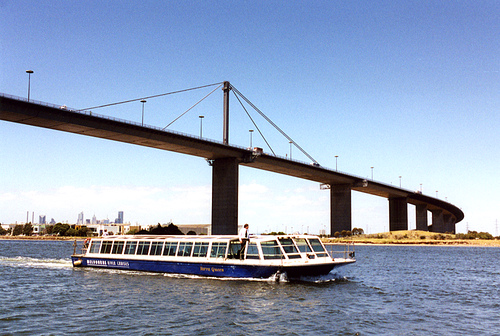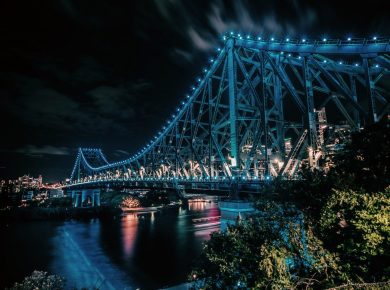Key points:
- The bridge limits the size of container ships coming to Australian ports
- This costs Australians about $1.5 billion per year
- Infrastructure Victoria should redo its analysis of reconfiguring Melbourne’s ports.
Everyone who drives from or to the west of Melbourne will have cursed the congestion on the West Gate Bridge. Fortunately some of that pain will be lessened by the construction of the new tunnel.
What is less obvious is the problem to shipping by the bridge being too low. Only ships up to 7500 containers (TEUs – twenty foot equivalent units) pass easily under the bridge. While there are other concerns with taking larger ships into the inner port, these can be overcome with investment. By contrast, the bridge is a hard constraint.
We all pay
The potential cost savings to Australia of upgrading from the current average 5,000 TEU vessel to an 11,000 TEU ship is about US$110 per TEU (Drewry 2018, p29).
Since Swanston Dock (upstream of the bridge) handles about 2 million containers per year, the direct and immediate cost to Victorians of the bridge being too low is about A$350 million per year.
The problem is actually worse. The planning for Webb Dock (downstream from the bridge) was also constrained to operate with ships of maximum size of 7500 TEU to accord with Swanston Dock. This means that the cost to Victorians by the undersized bridge applies to the whole 3 million TEU shipped annually, so that the direct cost is some A$500 million per year.
At current forecasts, there will be 6 million TEUs passing through the port in the early 2040s and the cost to Victorians will rise to A$1 billion per year.
Even Sydney and Brisbane pay
The problem is actually still worse. The container ships which come to Australia do a loop which includes the ports of Brisbane, Sydney and Melbourne.
“On the Australian trades, average vessels of 5,700 TEU are currently operating on the NE Asia-Australia route. The largest ship deployed on the Australian trade is the 7,455 TEU … While Sydney can handle ships of 10,000 TEU, Melbourne, with … limits imposed by the Yarra Channel, limits the Australian service to ships of less than 7,500 TEU (what is now considered a relatively small size for deep-sea trades).” (Drwery 2018).
These three cities handle about 8 million TEUs per year. The cost to Australia is thus about $A1.5 billion per year.
And Melbourne might be losing out relatively: its TEU throughput has grown more slowly over the last decade than the other major Australian ports.
What is to be done?
There seem two alternatives: either the bridge has to be rebuilt or the port relocated.
Infrastructure Victoria has opted to shift the port, but recommended but that this can wait until 2055. This advice seems wrong.
Its economic analysis is missing some major elements:
- It advocates restricting ship sizes below optimal and passing the excess costs on to Victorian consumers – “the shipping lines are likely to be able to pass on the costs of deploying smaller than optimal container ships to Swanson Dock to exporters and importers on Asian trades” (IV p.64) which actually means you and I;
- It ignores the potential benefits of re-purposing the land in the Port of Melbourne: “An opportunity cost of the underlying value of land was not available at this stage for this study. The upshot of this is that the case for relocation would be stronger than that presented here if such opportunity costs were taken into consideration.” (Deloitte 2017, p10).
Understating the cost of retaining the current port, and ignoring potential revenue from other uses of the land on which it stands, clearly overstate the case for extending the life of the current port to 2055.
In the past two decades Barcelona, Bremen, Copenhagen, Amsterdam, Oslo, Bilbao, Buenos Aires, Genoa, London and Cape Town have all moved their ports and liberated the land to create beautiful new cities in which people can work, live and play. Auckland is doing the same.
Melbourne will faces the same trade-off and will inevitably make the same decision: 2055 is probably too late.
References
Deloitte (2017) “Infrastructure Victoria Second Container Port: Economic Advice” https://www.infrastructurevictoria.com.au/wp-content/uploads/2019/04/Deloitte_Infrastructure_Victoria_Second_Container_Port_Advice_Economic_Advicev_22_FINAL-1.pdf
Drewry (2018) “Container ship fleet forecast and maritime economic assessment” advice provided to Infrastructure Victoria: https://www.infrastructurevictoria.com.au/wp-content/uploads/2019/04/Drewry_Container_Ship_Fleet_Forecast_and_Maritime_Economic_Assessment-2.pdf
Infrastructure Victoria (2017) “Advice on Securing Victoria’s Ports Capacity” https://www.infrastructurevictoria.com.au/wp-content/uploads/2019/04/Securing_Victorias_Ports_Capacity_WEB-1.pdf







